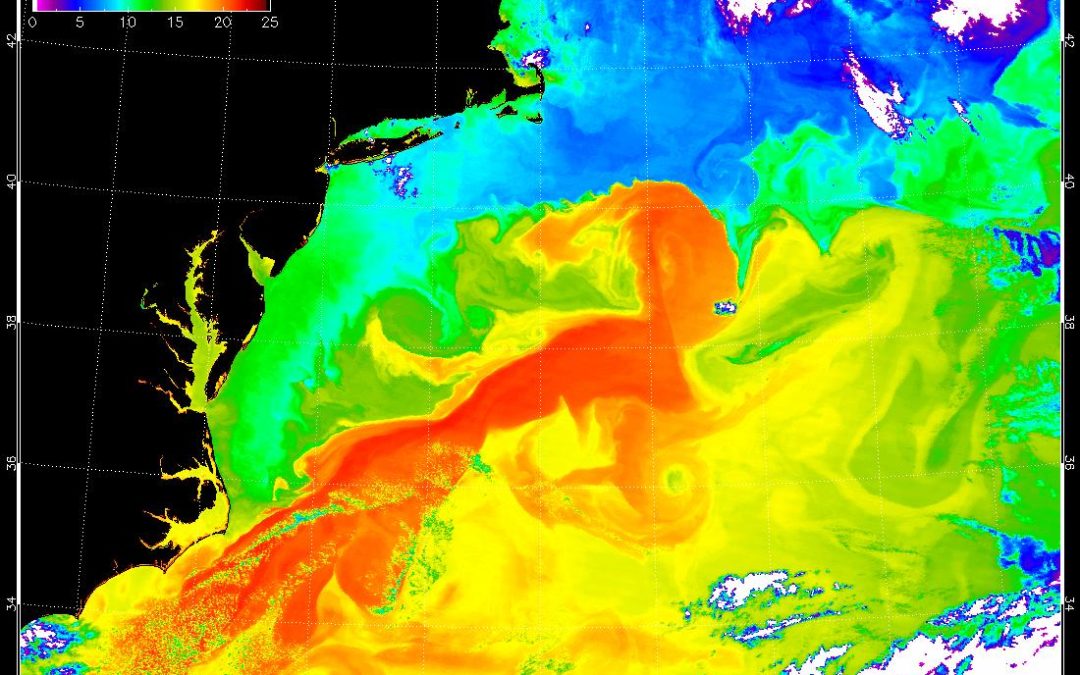Modified Source Extracts: Inside Climate News and The Guardian news article (dated 25 & 26th Feb. 2021) – The oceans have thousands of currents, gyres and eddies that carry water around the planet. Their movements regulate the Earth’s climate and transport carbon, heat and nutrients.
Together, these currents act like a giant conveyor belt that transfers heat from the tropics to the higher latitudes. Its an integrative system – if one part of the system is showing signs of stress then other parts are likely to follow suit.
As warm water from the tropics flows toward the poles in wind-driven currents near the surface, it cools, becoming denser and heavier, and eventually sinks. It then begins flowing back toward the equator in a slow journey deep in the ocean.
Scientists call this the thermohaline circulation because it’s driven by both temperature and salinity.
The Atlantic Ocean Conveyor Belt
In the Atlantic, the ocean conveyor belt is known as the Atlantic Meridional Overturning Circulation, or AMOC for short. The Gulf Stream, a wind-driven current that brings warm water northward along the U.S. coast, is a key part of it.
This current system has played a key role in shaping the climate of eastern North America and Western Europe-Scandinavia, and thus the development of societies and civilizations located there.
Alarming tell-tale signs
New research, published this week in the journal Nature Geoscience, indicates that Altantic current circulation has now weakened more than at any other time during at least the last 1,000 years. This research is focused mainly on measuring the changes in the volume of the Gulf Stream – a significant part of the North Atlantic circulation, which moves 100 times more water than the Amazon River.
The Gulf Stream flows northeast, parallel to the East Coast of the United States, mostly near the sea surface, then veers across the ocean to warm the higher latitudes of Northern Europe. Some of that water also cools and sinks in the subpolar region and starts flowing south.
“If we continue to drive global warming, the Gulf Stream System will weaken further, by 34 to 45 percent by 2100 according to the latest generation of climate models,” said co-author Stefan Rahmstorf, a climate scientist with the Potsdam Institute for Climate Impact Research.
Scientists examined a number of different types of records that measured its strength. One of which was analysing the chemistry of fossil shells that show how water temperature changes, and the size of sediments dropped by parts of the Gulf Stream system show the force of the flow, said co-author David Thornalley, a paleoceanographer at University College, London. When it’s moving slowly, it deposits fine silt and mud, like a lazy river does, but faster flows transport larger sediments, more like the gravels found in swift mountain streams, he said.
Other data sets include measurements that show where different water masses originated. The distribution of subtropical or subpolar water masses says a lot about the vigour of the circulation, Rahmstorf added.
Consistent Results
The researchers compared results from 11 different data sets that measure the changing strength of the circulation during the past 1,000 years, and nine of them were in robust agreement, said co-author Niamh Cahill, a statistician at Maynooth University in Ireland. Together, the data show a “consistent picture” of unprecedented weakening of the circulation, she said.
A fairly consistent picture of the AMOC has emerged: after a long and relatively stable period, there was an initial weakening starting in the nineteenth century, followed by a second, more rapid, decline in the mid-twentieth century, leading to the weakest state of the AMOC occurring in recent decades.
If it walks like a duck, and it quacks like a duck…
The study strongly suggests that the cause of the weakening is human-caused climate change, said Philip Duffy, director of the Woodwell Climate Research Center in Falmouth, Massachusetts.
“Many climate model simulations going back decades predict exactly this as a consequence of human-caused climate change,” he said. “So, if it walks like a duck, and it quacks like a duck”.
“The strength of this paper is that we have all the different indicators pointing toward the same conclusion,” he said.
If the AMOC continues to weaken at the pace shown by the new research, it would affect temperatures and weather patterns in all countries bordering the Atlantic Ocean, as well in the ocean itself by changing regional rainfall patterns around the equator including more dryness in subtropical zones and across the Northern Hemisphere in general, according to NOAA’s National Climatic Data Center.
Karsten Haustein, of the Climate Services Center in Germany, a researcher independent of the study, said the US could be at risk of stronger hurricanes as a result of the Gulf Stream’s weakening. “While the AMOC won’t collapse any time soon, the authors warn that the current could become unstable by the end of this century if warming continues unabated,” he said. “It has already been increasing the risk for stronger hurricanes at the US east coast due to warmer ocean waters, as well as potentially altering circulation patterns over western Europe.”
Enhanced sea level rise
Dr Levke Caesar, of Maynooth University in Ireland, and the lead author of the paper, said sea level rises on the east coast of the US were another potential consequence. “The northward surface flow of the AMOC leads to a deflection of water masses to the right, away from the US east coast. This is due to Earth’s rotation that diverts moving objects such as currents to the right in the northern hemisphere and to the left in the southern hemisphere,” she said. “As the current slows down, this effect weakens and more water can pile up at the US east coast, leading to an enhanced sea level rise.”
Are we closer to that catastrophic tipping point ?
According to Andrew Meijers, the deputy science leader of polar oceans at British Antarctic Survey “The AMOC is frequently modelled as having a tipping point below some circulation strength, a point at which the relatively stable overturning circulation becomes unstable or even collapses. The ongoing weakening of the overturning means we risk finding that point, which would have profound and likely irreversible impacts on the climate.”
Integrative Ocean-Atmospheric Systems
If one portion of the global ocean-atmosphere system is showing signs of stress then there is strong likelihood that other parts of the conveyor belt are similarly under stress. Here in New Zealand/Aotearoa there is certainty that we will be affected by more frequent severe weather events caused by ocean-atmosphere changes occurring in the SW Pacific sector.
Who to call about your property exposure to climate-related hazards
How prepared are you for these sort of unpredictable severe weather events ? Do you think your property might be susceptible to coastal inundation, flooding, erosion and/or slope instability?
If you’re unsure – let us help by contacting Geohazard Assessment Services to arrange an expert and affordable site-specific assessment to identify any potential issues – afterall when thinking about buying a property – its infinitely better (for peace-of-mind) to ‘know the ground beneath your feet’
Cover Photo Credit: NASA -Earth Observatory
On May 2, 2001, the Moderate-resolution Imaging Spectroradiometer (MODIS) – a key instrument aboard the multi-national NASA scientific research satellite TERRA obtained this spectacular image of the Atlantic Ocean’s Gulf Stream. The false colours in the image represent “brightness temperature” observed at the top of the atmosphere. The brightness temperature values represent heat radiation from a combination of the sea surface and overlying moist atmosphere.
The red pixels in this image show the warmer areas (approaching 25°C), greens are intermediate values (12-13°C), and blues are relatively low values (less than 10°C). Notice the considerable detail in the swirls and gyres of the current patterns in the Gulf Stream.


Recent Comments